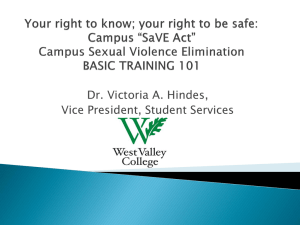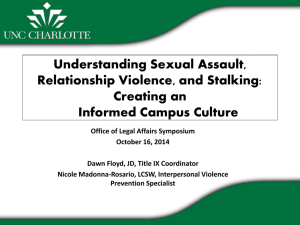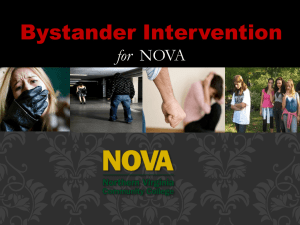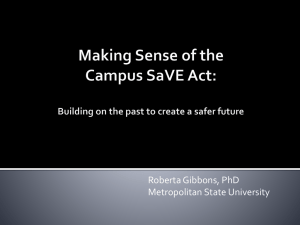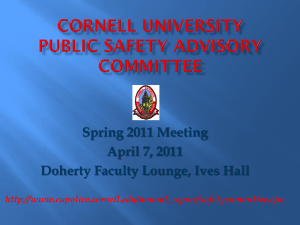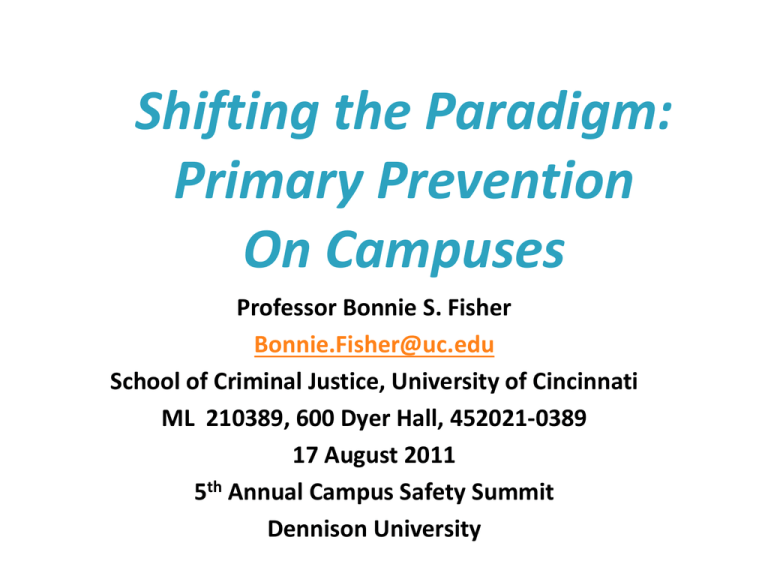
Shifting the Paradigm:
Primary Prevention
On Campuses
Professor Bonnie S. Fisher
Bonnie.Fisher@uc.edu
School of Criminal Justice, University of Cincinnati
ML 210389, 600 Dyer Hall, 452021-0389
17 August 2011
5th Annual Campus Safety Summit
Dennison University
Acknowledgements
• Multi-disciplinary Research Team
– University of Kentucky
•
•
•
•
Ann Coker, PhD
Corrine M. Williams, ScD
Emily R. Clear, MPH, CHES
Patricia Cook-Craig, PhD
– University of South Carolina
• Suzanne Swan, PhD and her UG & graduate students
– American University
• Jane Palmer, ABD
– University of Cincinnati
• Billy Henson, former graduate student, PhD
• Heidi Scherer, former graduate student, PhD
Objectives of Presentation
• Provide information
– Background facts about sexual violence against college
women
– Information about what is known about current prevention
strategies on campuses
– Overview of primary prevention, specifically focus on
engaging in bystander intervention and Green Dot
– Evaluation results from Green Dot at one campus
• Results
• Lessons learned
– References/resources
• Generate ideas from YOU!
– Conversation about your prevention and assessment efforts
on your campus
• Lessons learned and future directions
Background to
Violence Against College Women
• Up to 25% of women may experience
attempted or completed raped during college
(Fisher, Cullen, & Turner, 2000)
• 5.2% of college women raped in the last year
(5.5 times higher than women in general
population) (Kilpatrick, et al., 2007)
– 1.8% forcibly raped (3.4 times higher)
– 3.6% experienced drug-facilitated
rape/incapacitated rape (8.5 times higher)
Background to
Violence Against College Women
• Repeat Sexual Victimization
– Of 16% of women experienced at least one
form of sexual victimization, 47% were repeat
victims during an academic year
• Repeat Rape
– Of the 3% of college women who experienced
rape, 23% were repeat victims (experienced
two or more rapes) during an academic term
(Fisher, Daigle, and Cullen, 2010)
Background
• Dating and sexual violence (DV/SV) rates are
highest among those in their late teens to
mid-twenties; thus college students are at the
age of greatest risk
• Campus Sexual Assault Study (Krebs, et al.,
2009), since entering college
– 17% threatened/humiliated by a dating partner
– 6% physically hurt by a dating partner
• 13% stalked, many by current/former boyfrd,
in an academic year (Fisher, et al. 2000)
Federal Legislation
• Jeanne Clery Disclosure of Campus Security and Policy and
Campus Crime Statistics Act (Clery Act)
– Disclose publicly annual crime statistics, inc sexual
offenses
– State sexual assault policy
– Describe the educational programs provided by the
school to promote awareness of sexual assault
• Congressional OVW funds to encourage developing
programs that address dating violence, sexual assault and
stalking on college campuses
• Proposed legislation: Campus Sexual Violence Elimination
Act
ReAction on College Campuses
• Implementation of awareness and risk
reduction programs
– Rape knowledge and changing rape supportive
attitudes/rape myths
– Awareness strategies have sought to increase
students’ knowledge about the dangers of sexual
violence and what intervention programs are
available
– Risk reduction strategies seek to teach women
strategies for reducing the likelihood that they
would be victimized
Effectiveness of College Programs
– None have worked well to reduce rape; overall
effectiveness questionable at best (Lonsway, et al.,
2009)
• Rape knowledge, changing supportive attitudes and rape
myths, and awareness strategies
– Increases in knowledge/changes in attitudes but effects are and
short term—diminish over time
– Effects on actual behavior negligible, if at all
• Risk reduction strategies
– Self-defense deters the completion of an attempted rape (Ullman,
2007; Fisher, et al., 2007)
• Forceful physical resistance (e.g., biting, scratching, hitting)
• Forceful verbal resistance (e.g., screaming, yelling, swearing)
– Repeat victimization
• Self-protection reduces risk of repeat incident (Fisher, et al.,
2010)
Primary Prevention of Sexual Violence
• What is primary prevention?
– Public health perspective (primary, secondary, tertiary)
– Occurs before the onset of the problem, with the goal to
reduce the actual incidence of the problem and to
promote general well being to targeted audience
(McMahon, et al., 2011)
• Campus application of primary prevention
– Involves developing comprehensive strategies that stop
sexual violence before initial perpetration or
victimization, especially those that make community
level changes (Lee, et al. 2011)
Example of Campus Primary Prevention
• Active/Engaging Bystander Intervention Programs
– Teach and encourage bystanders who are aware of or
observe situations and interactions that could lead to sexual
harassment, intimidation, coercion, or assault, IPV/dating
violence, or stalking
– Goals
• Increase awareness and understanding of the problem of
sexual violence
• Increase feelings of responsibility to solve the problem
• Increase commitment to act
• To empower people to act both individually and collective
by fostering a sense of caring and community, campus
cultures can be transformed and become safer
Key Components of Empowering Bystanders
• Develop a sense of competence and identify
situations for intervening
• Teach/build a repertoire of specific intervention
skills for bystanders to use (Moynihan and Banyard,
2008)
– Interrupt abusive or potentially risky situations/possible
sexual victimization
• Foster bystander’s sense of responsibility for
intervening
• Provide role models of helping behavior
• Create new situational norms of intervention
• Support bystander intervention on campus
– Social marketing promotions (Banyard, et al., 2007;
Edwards, 2009)
Evaluations of Bystander Interventions
• Men's Project (Barone, et al., 2007)
– Recruited male college students on athletic teams, in
fraternities and male residence halls
– Found that having a support group was essential to
their ability to challenge their sexist environment and
effectively use bystander behaviors
• Banyard, Moynihan, & Plante (2007)
– First empirical evidence that a bystander intervention
for sexual violence prevention resulted in significant
and sustained changes in knowledge, attitudes, and
bystander behaviors in both college men and women
Violence Prevention Intervention:
Green Dot
• Developed by Dr. Dorothy Edwards, former Director of
the Violence Intervention and Prevention (VIP) Center
at University of Kentucky
• Purpose
• To increase proactive bystanding behaviors and reduce
dating and sexual violence on college campuses
• Logic
• Understanding how perpetrators target victims allows
the bystander to assess the situation, view their options
for action and select a safe proactive bystanding
behavior that they are willing to carry out
Green Dot: Two Phases
• Phase One
• Persuasive
Speech
• Phase Two
• Students
Educating and
Empowering to
Develop
Safety (SEEDS)
• Peer Opinion
Leaders (POL)
Implementation of Green Dot: Phase One
• Phase One: 50-minute Persuasive Speech
– 1st yr students: UK 101, I cr hr intro to college transition
– Introduce concept of active bystanding and build
audience’s commitment to prevention
• Purposes of speech
– To help students find their connection to dating and
sexual violence (D/SV)
– Build awareness of the problem D/SV
– present a bystander intervention as a manageable and
simple activity
– persuade/motivate students to get involved in
prevention/link them to UK VIP Center
Phase Two: Recruitment into SEEDS
• Students invited at • Peer Opinion
end of persuasive
Leaders (POL)
speech to attend
strategy to recruit
Students
for SEEDS
Educating and
Empowering to
Develop Safety
(SEEDS)
Peer Opinion Leaders (POL)
Recruitment
• Faculty, staff, students, Resident Assistants
– Identified and nominated POLS whom they thought
were respected and influential
– Students nominated more than once were ided as POLS
– POLS sent a letter stating that they were nominated to
come to a training reception to help influence the legacy
they leave behind at UK
Students Educating and Empowering
to Develop Safety (SEEDS)
• Focus
– Preventing perpetration behavior by providing students
with skills to be a proactive bystander to violence
• Students attend small group, intensive sessions
– Voluntary and open to all students
• SEEDS training
• Trained in recognizing and implementing proactive
bystanding behaviors
– What is known about bystanders
– Barriers to intervening
– Perpetrators and patterns of perpetration
Green Dot Program
• Similarities w existing bystander prevention
programs
– Overview of VAW/detailed perp info to guide and inform
bystander responses
– Discussion of bystander role
– Skill-building opportunities
• Distinction between Green Dot and other programs
– Emphasis targeted recruitment strategies based on POLS
– POLs potentially optimize the effectiveness and efficacy
of the bystander approach as those most socially
influential are most likely to influence others to engage
in proactive bystanding
Evaluation of Green Dot at
University of Kentucky
• Objective
– To evaluate the efficacy of Green Dot in a
sample of college students
– Examined effects of Green Dot on
• Actual and observed bystanding
behaviors by intervention
• Social norms associated with dating and
sexual violence (Coker, et al., 2011)
Study Design
• Field period: Spring 2010
• Random sample of 2,000 students from each class
(Freshman-Seniors); ½ sample per class was male
• Recruitment letter to participate in study
– $2 cash sent via the mail to participate in a web-based
survey
– Email with Zoomerang survey link was sent two days
later
– Reminders via email were sent approximately every
three days for two weeks
Response Rate
• Of the 7,945 students invited to participate in
the web-based survey
– 3,872 clicked on the link to the web-site
– 3,417 completed the survey
• The overall response rate was 43%
– 88% of those who clicked on the link completed
the survey
• Analytic Sample Size = 2,484 (excluded
incomplete surveys and students >26)
Sample Demographics
Demographic
Characteristic
Undergraduate
Population
(Spring 2010)
18,806
Random
Sample
Analytic
Sample
7,945
2,484
% Female
49.8%
49.6%
60.4%***
% White
84.1%
83.8%
84.6%
22.1 (4.4)
22.4 (5.0)
21.0 (2.0)
% Freshman
21.2%
25.1%
28.9%***
% Fraternity /
Sorority
13.0%
--
17.0%**
N
Mean age (SD)
*** p <0.0001; ** p = 0.001
Intervention Exposure Measure
• Hierarchical Green Dot Exposure Matrix:
THREE GROUPS
–Any SEEDS training (n=351)
• 95% had heard a Green Dot speech
• 42% were VIP volunteers or clients
–Green Dot Speech only (n=693)
–Unexposed group (n=1281): no SEEDS
training, no connection with VIP, never
heard a Green Dot speech
Actual and Observed
Bystanding Behaviors
• 12 items about behaviors used or observed in
the current school year
• Response options: 0=not at all; 1=1-2 times;
2=3-5 times; 3=6 or more times
• Scores ranged from 0-36
• Higher score, more behaviors (actual or observed)
• Sample survey items
– Spoke up if somebody said that someone deserved
to be raped or to be hit by their partner
– Asked someone that looked very upset if they were
okay or needed help
Acceptance of General
Dating Violence Scale
• 5 items with responses from strongly disagree
(=1) to strongly agree (=4)
• Scores range from 5-20
– Higher scores indicate greater acceptance of dating
violence
• Sample survey items
– There are times when dating violence between
couples is okay.
– Someone who makes their partner jealous on purpose
deserves to be hit.
Illinois Rape Myth Acceptance Scale
• 7 items with responses from strongly disagree
(=1) to strongly agree (=4)
• Scores range from 7-28
– Higher scores indicate greater acceptance of rape
myths
• Sample survey items
– When women are raped, it is often because the way
they said “no” was unclear.
– A woman who dresses in skimpy clothes should not
be surprised if a man tries to force her to have sex
Statistical Analyses
• Multiple Analysis of variance (MANOVA) was
used to test all hypotheses
– Controlled for gender, class, social fraternity or
sorority affiliation, current relationship status, and
parental education
• Conducted using SAS 9.2
Manova Analyses Results: Norms
Adjusted Mean Scores (F, p value)
Outcome Measure
SEEDS trained
(n=351)
Green Dot Speech
alone
(n=693)
No Intervention
(n=1281)
Illinois Rape Myth
Acceptance
9.40 (5.92, .01)
9.58 (2.07, .15)
10.45(REF)
Acceptance of
General Dating
Violence
5.65 (0.99, .31)
5.65 (.00, .94)
5.70 (REF)
Manova Analyses Results:
Bystanding
Adjusted Mean Scores (F, p value)
Outcome
Measure
SEEDS trained
(n=351)
Green Dot Speech
alone
(n=693)
No Intervention
(n=1281)
Observed
Active
Bystanding
12.29 (144.81, <.0001)
11.45 (38.24, <.0001)
7.17 (REF)
Actual Active
Bystanding
12.22 (95.71, <.0001)
11.45 (18.38, <.0001)
8.32 (REF)
RESULTS
• All levels of the intervention significantly
increased bystanding behaviors
• SEEDS trained students reported a significant
increased in actual and observed active
bystanding compared to students who heard a
Green Dot speech.
• While having heard a Green Dot speech alone
may have an effect on increasing bystanding
behaviors, the addition of SEEDS training
noticeably increased active bystanding behaviors
Discussion of Findings
• Findings are consistent with other recent
studies which provide evidence for the
promise of a bystander approach to address
sexual violence
• Green Dot persuasive speeches alone (50minute intervention) do have some effect on
increasing bystanding behaviors
– Implications for cost-effective prevention
intervention
Limitations
• Selection bias
– Survey response rates
• SEEDS training
– May be those with greater interest in violence
prevention
– Possibly more likely to engage in bystanding
behaviors because they or someone they know
may have experienced violence or they had
another important connection to violence and
need for prevention efforts
What Did We Learn from Evaluation?
• Green Dot significantly increased both
observed and actual bystanding behaviors in
the general population of students
• SEEDS training, which is primarily bystander
capacity and efficacy, is superior to Green Dot
speeches alone
What Did We Learn While
Assessing Green Dot?
• Importance of Researcher-Practitioner
Collaboration
– Communication about program and evaluation
– Brain storming together!
– Building trust with each other over time
– Team approach to evaluation/assessment of Green Dot
program
• Importance of Multi-Disciplinary Team (having fun!)
– Victimology, public health, psychology, women’s studies,
statistics/methods, social work, law and society
What Did We Learn While
Assessing Green Dot?
• Survey Design
– Took time but well worth the investment
– Victimization/perpetration, bystanding,
demographics, lifestyle questions…LOTS OF DATA
• Recruitment Letter
– Takes time to count out 2 $1.00 bills..but fun, too!
• Survey Administration
– Web-based survey easy to create
• Fast/inexpensive way to get LOTS of data quickly
– $2.00 incentive increased response rate
Now and What Lies Ahead?
• WHERE WE ARE NOW
– More rigorous assessment of Green Dot
• Three campus study in the field
• Year 2 data collected Spring 2011
• Year 3 plans in the works!
• FUTURE PLANS
– Consortium of schools involved in Green Dot
implementation & evaluation with standardized
methodology
• Web-based survey with same set of core q’s
• Baseline with Year 2 and beyond
GENERATING IDEAS: WHAT IS
HAPPENING ON YOUR CAMPUS?
• Types of prevention programs
– IPV/Dating violence
– Sexual violence
– Campus crime more generally
• Evaluation of Program Effectiveness
– Outcome measures/Results
– Plans to assess current prevention programs
• Lessons learned
– Implementation
– Process/Outcome Evaluation
References/Resources
American College Health Association. (2008). Shifting the Paradigm:
Primary Prevention of Sexual Violence. www.acha.org (see for Lee, et
al., Sexual Violence Prevention).
Banyard VL, Moynihan MM, Plante EG. (2007) Sexual violence
prevention through bystander education: An experimental
evaluation. Journal of Community Psychology, 35:463-81.
Barone RP, Wolgemuth JR, Linder C. (2007) Preventing sexual assault
through engaging college men. Journal of College Student
Development, 2007 48:xxx-xxx.
Coker AL, et al. (2011) Evaluation of Green Dot: An Active Bystander
Intervention to Reduce Sexual Violence on College Campuses.
Violence Against Women, 17:777-796.
Edwards, DJ. (2009) Ending Violence…One Green Dot at a Time,
Instructor Manual. Lexington, KY.
References/Resources
Fisher B, Daigle LE, Cullen FT. (2010) Unsafe in the ivory tower : the
sexual victimization of college women. Los Angeles: Sage
Publications.
Fisher, Bonnie S., Leah Daigle, Francis T. Cullen, and Shannon Santana.
(2007) “Assessing the Efficacy of the Protective Action-Completion
Nexus for Sexual Victimization.” Violence and Victims. 22:18-42.
Fisher B, Cullen F, Turner M. (2000) The sexual victimization of college
women. Washington, DC: Dept of Justice, Office of Justice Programs,
NIJ. https://www.ncjrs.gov/pdffiles1/nij/182369.pdf
Kilpatrick, DG, et al. (2007) Drug-facilitated, Incapacitated, and Forcible
Rape: A National Study. DC: Dept of Justice, Office of Justice
Programs, NIJ. https://www.ncjrs.gov/pdffiles1/nij/grants/219181.pdf
Krebs, CP, et al. (2009). The Differential Risk Factors of Physically Forced
and Alcohol- or Other Drug-Enabled Sexual Assault Among University
Women. Violence and Victims, 24: 303-321.
References/Resources
Lonsway, KA, et al. (2009). Rape Prevention and Risk Reduction:
Review of the Research Literature for Practitioners. VAWNET,
National Online Resource Center for Violence Against Women.
http://oregonsatf.org/prevention/docs/Rape_Prevention_Risk_Reduct
ion.pdf
Moynihan MM, Banyard VL. (2008) Community responsibility for
preventing sexual violence: A pilot study with campus Greeks and
intercollegiate athletes. Journal of Prevention & Intervention in the
Community, 36:23-38.
McMahon, S. et al. (2011) Conceptualizing the Engaging Bystander
Approach to Sexual Violence Prevention on College Campuses.
Journal of College Student Development, 52:115-128.
Ullman, S. (2007). A 10-year update of the “review and critique of the
empirical studies of rape avoidance” Criminal Justice and Behavior,
34:411-429.



